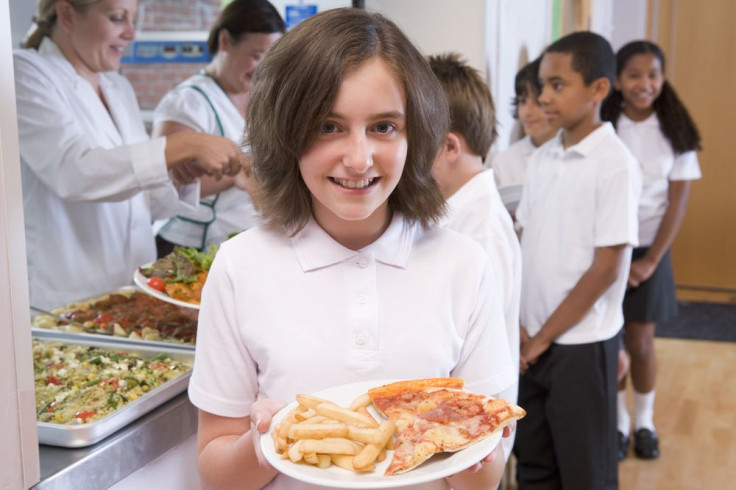Junk Food May Be Prohibited In School Lunches This Fall; Pending Federal Law Sparks Obesity Debate

Gone are the days of chicken fingers, pizza, and French fries at lunchtime, it seems. For students attending schools who participate in the National School Lunch Program, they will have to get used to the new the U.S. Department of Agriculture's Smart Snacks in School nutrition standards, which went into effect July 1, that prohibit public schools from providing junk food-laden school lunches — in the ongoing battle against the child obesity epidemic.
The new guidelines are a part the U.S. Department of Agriculture’s Smart Snacks in School nutrition standards, created as a result of the Healthy, Hunger-Free Kids Act. According to the new rules, middle schools would no longer be allowed to provide sugary drinks, like lemonade and fruit punch, and all caffeinated drinks, like coffee and soda, to students at lunch. At some schools, kids won’t be able to enjoy Chick-fil-A sandwiches for lunch anymore or celebrate birthdays with cakes and cookies. In other schools, vending machines will be cut off at breakfast and lunch in order to meet the latest guidelines. “Obesity is not just a health issue, it’s an economic and a national security issue,” said Kevin Concannon, USDA undersecretary for food, nutrition, and consumer services.
Currently, over 31 million children eat school lunches, according to first lady Michelle Obama’s “Let’s Move” campaign page. For some students, school is the only place they get a meal. In low-income communities, fast food is easy to access and affordable, but healthy food is inaccessible and very expensive. Although Obama can’t control what parents feed their kids at home, she believes offering only healthy options at school will reduce childhood obesity rates.
The Healthy Hunger-Free Kids Act
One out of three children are obese. The Healthy, Hunger- Free Kids Act of 2010 was created to lower these alarming statistics by setting new federal standards on food. The act is a key component of the “Let’s Move” campaign, created by the first lady to help reduce childhood obesity rates and make healthy food accessible to low income communities. The act gives the USDA authority to set nutritional standards, helps establish local farms, builds on USDA work to improve the quality of food, expands access to drinking water, and provides funding for schools so they can meet new nutritional standards — only a few of the act’s initiatives to increase access to healthy meals and monitor nutritional standards.
A University of California, Berkeley study showed a majority of California parents and kids liked healthier lunch choices offered in school, but parents in other parts of the United States had opposing opinions. A Florida family was upset when they were told they could no longer pack lunches for their daughter. To follow the newly enforced nutritional guidelines, their daughter’s school banned all packed lunches.
“We took it as our lunches didn’t qualify,” Jeff Carreira, father of the 4-year-old daughter, told The Blaze. Kids are also expressing their anger regarding the new food guidelines. The hashtag #BringBackOurSnacks is flooding Twitter feeds. “Thanks to @MichelleObama, lunch has turned into another class,” Alex Bozman tweeted. “We learn how to survive on grass and gluten-free fries.” Students are posting up photos of their new lunches with disgusted faces. As a result of Michelle Obama’s new policy, 1,086,00 students stopped buying school lunch, the Washington Times reported. At one middle school and high school, kids boycotted for three weeks after their school changed their sandwiches to meet federal standards.
Kids Addicted to Junk Food?
Why are kids so angry? What is it about high calorie, high sugar, and high sodium foods that kids so desperately desire? Three words might explain it all: junk food addiction. Michael Moss, author of Salt Sugar Fat: How the Food Giants Hooked Us gives an explanation for these junk food cravings. He told Mental Floss that some foods are purposely made with bland ingredients so that you crave more food or you just add enough sugar or salt until your mouth explodes with flavor.
Puffy snacks, for example, melt very quickly in your mouth, so you desire another bag. There can’t be that many calories if the food just evaporated on my tongue right? One bag of Cheetos has 150 calories, according to Frito Lays nutritional label. That doesn’t sound too bad, but once you have three bags, that’s 450 calories and 750 milligrams of sodium.
Food scientist Steven Witherly called puffy snacks “one of the most marvelous constructed foods on the planet, in terms of pleasure.” As far as sugary snacks, new research shows sugar may be just as addicting as crack. Maybe that’s why kids don’t want to end their bake sales.
Would the new federally enforced plan work? Some children may adjust and embrace the healthier options while others may choose to stop eating school lunch or simply find other ways to sneak in their favorite junk foods. For now, we can rely on education to help teach kids and parents the importance of eating nutritious foods and the dangers of excessive fast food.



























